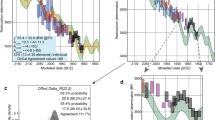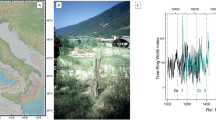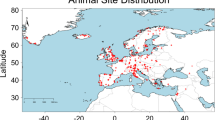Abstract
Recent discoveries of rapid changes in the atmospheric 14C concentration linked to solar particle events have spurred the construction of new radiocarbon annual calibration datasets1,2,3,4,5,6,7,8,9,10,11,12,13. With these datasets, radiocarbon dating becomes relevant for urban sites, which require dates at higher resolution than previous calibration datasets could offer. Here we use a single-year radiocarbon calibration curve to anchor the archaeological stratigraphy of a Viking Age trade centre in time. We present absolutely dated evidence for artefact finds charting the expansion of long-distance trade from as far away as Arctic Norway and the Middle East, which we linked to the beginning of the Viking Age at ad 790 ± 10. The methods developed here enable human interactions and cultural, climatic and environmental changes to be compared in archaeological stratigraphies worldwide.
This is a preview of subscription content, access via your institution
Access options
Access Nature and 54 other Nature Portfolio journals
Get Nature+, our best-value online-access subscription
$29.99 / 30 days
cancel any time
Subscribe to this journal
Receive 51 print issues and online access
$199.00 per year
only $3.90 per issue
Buy this article
- Purchase on Springer Link
- Instant access to full article PDF
Prices may be subject to local taxes which are calculated during checkout



Similar content being viewed by others
Data availability
All data are available in the Article or the Supplementary Information. Additional information about the site and excavation can be found at https://projects.au.dk/northernemporium/, and additional artefact photographs can be found at http://sol.sydvestjyskemuseer.dk/ using the search term ‘SJM 3’.
Code availability
All code is available in the Supplementary Information.
References
Reimer, P. J. et al. The IntCal20 Northern Hemisphere radiocarbon age calibration curve (0–55 kcal BP). Radiocarbon 62, 725–757 (2020).
Büntgen, U. et al. Tree rings reveal globally coherent signature of cosmogenic radiocarbon events in 774 and 993 CE. Nat. Commun. 9, 3605 (2018).
Dee, M. et al. Supernovae and single-year anomalies in the atmospheric radiocarbon record. Radiocarbon 59, 293–302 (2016).
Fogtmann-Schulz, A. Cosmic ray event in 994 C.E. recorded in radiocarbon from Danish oak. Geophys. Res. Lett. 44, 8621–8628 (2017).
Jull, A. J. T. et al. More rapid 14C excursions in the tree-ring record: a record of different kind of solar activity at about 800 BC? Radiocarbon 60, 1237–1248 (2018).
Wang, F. Y. et al. A rapid cosmic-ray increase in BC 3372–3371 from ancient buried tree rings in China. Nat. Commun. 8, 1487 (2017).
Mekhaldi, F. et al. Multiradionuclide evidence for the solar origin of the cosmic-ray events of AD 774/5 and 993/4. Nat. Commun. 6, 8611 (2015).
Park, J. et al. Relationship between solar activity and 14C peaks in AD 775, AD 994, and 660 BC. Radiocarbon 59, 1147–1156 (2017).
Miyake, F. et al. Large 14C excursion in 5480 BC indicates an abnormal sun in the mid-Holocene. Proc. Natl Acad. Sci. USA 114, 881–884 (2017).
Dee, M. W. & Pope, B. J. S. Anchoring historical sequences using a new source of astro-chronological tie-points. Proc. R. Soc. A 472, 20160263 (2016).
Wacker, L. et al. Radiocarbon dating to a single year by means of rapid atmospheric 14C changes. Radiocarbon 56, 573–579 (2014).
Kuitems, M. et al. Radiocarbon-based approach capable of subannual precision resolves the origins of the site of Por-Bajin. Proc. Natl Acad. Sci. USA 117, 14038–14041 (2020).
Miyake, F. et al. A signature of cosmic-ray increase in AD 774–775 from tree rings in Japan. Nature 486, 240–242 (2012).
Büntgen, U. et al. 2500 years of European climate variability and human susceptibility. Science 331, 578–582 (2011).
Cook, E. R. et al. Old World megadroughts and pluvials during the Common Era. Sci. Adv. 1, e1500561 (2015).
Misra, P., Tandon, S. K. & Sinha, R. Holocene climate records from lake sediments in India: assessment of coherence across climate zones. Earth Sci. Rev. 190, 370–397 (2019).
Denniston, R. F. & Luetscher, M. Speleothems as high-resolution paleoflood archives. Quat. Sci. Rev. 170, 1–13 (2017).
Dahl-Jensen, D. et al. Eemian interglacial reconstructed from a Greenland folded ice core. Nature 493, 489–494 (2013).
Margaryan, A. et al. Population genomics of the Viking world. Nature 585, 390–396 (2020).
Hansen, V. The Year 1000. When Explorers Connected the World – And Globalization Began (Scribner, 2020).
Hodges, R. & Whitehouse, D. Mohammed, Charlemagne and the Origins of Europe. The Pirenne Thesis in the Light of Archaeology (Duckworth, 1983).
Noonan, T. S. The Islamic World, Russia and the Vikings, 750–900. The Numismatic Evidence (Routledge, 1998).
McCormick, M. Origins of the European Economy: Communications and Commerce AD 300–900 (Cambridge Univ. Press, 2001).
Jankowiak, M. in Viking-Age Trade: Silver, Slaves and Gotland (eds Gruszczyński, J. et al.) (Routledge, 2020).
Barrett, J. H. What caused the Viking Age? Antiquity 82, 671–685 (2008).
Hodges, R. Dark Age Economics: A New Audit (Bloomsbury Academic, 2012).
Wickham, C. Framing the Early Middle Ages: Europe and the Mediterranean, 400–800 (Oxford Univ. Press, 2005).
Baug, I. et al. The beginning of the Viking Age in the West. J. Marit. Archaeol. 14, 43–80 (2019).
Schrijver, C. J. et al. Estimating the frequency of extremely energetic solar events, based on solar, stellar, lunar, and terrestrial records. J. Geophys. Res. Space Phys. 117 (2012).
Baroni, M. et al. Volcanic and solar activity, and atmospheric circulation influences on cosmogenic 10Be fallout at Vostok and Concordia (Antarctica) over the last 60 years. Geochim. Cosmochim. Acta 75, 7132–7145 (2011).
Stuiver, M. & Braziunas, T. F. Sun, ocean, climate and atmospheric 14CO2: an evaluation of causal and spectral relationships. The Holocene 3, 289–305 (1993).
Kuitems, M. et al. Evidence for European presence in the Americas in AD 1021. Nature https://doi.org/10.1038/s41586-021-03972-8 (2021).
Croix, S. et al. Single context, metacontext, and high definition archaeology: Integrating new standards of stratigraphic excavation and recording. J. Archaeol. Method Theory 26, 1591–1631 (2019).
Yang, J. & Ren, P. BFDA: a MATLAB toolbox for Bayesian functional data analysis. J. Stat. Softw. 89, 21 (2019).
Buck, C. E. et al. Combining archaeological and radiocarbon information: a Bayesian approach to calibration. Antiquity 65, 808–821 (1991).
Bronk Ramsey, C. Bayesian analysis of radiocarbon dates. Radiocarbon 51, 337–360 (2009).
Callmer, J. in Glass beads – Cultural History, Technology, Experiment and Analogy. Proceedings of the Nordic Glass Bead Seminar 16th–18th October 1992 Studies in Technology and Culture 2. Lejre (eds Rasmussen, M. et al.) 49–54 (1995).
Sindbæk, S. M. in Urban Network Evolutions: Towards a high-definition archaeology (eds Raja, R. and Sindbæk, S.) 161–166 (Aarhus Univ. Press, 2018).
Ashby, S., Coutu, A. & Sindbæk, S. Urban networks and arctic outlands: craft specialists and reindeer antler in Viking towns. Eur. J. Archaeol. 18, 679–704 (2015).
Luterbacher, J. et al. European summer temperatures since Roman times. Environ. Res. Lett. 11, 024001 (2016).
Kerr, T. R., Swindles, G. T. & Plunkett, G. Making hay while the sun shines? Socio-economic change, cereal production and climatic deterioration in Early Medieval Ireland. J. Archaeolog. Sci. 36, 2868–2874 (2009).
Sukhodolov, T. et al. Atmospheric impacts of the strongest known solar particle storm of 775 AD. Sci. Rep. 7, 45257 (2017).
Reimer, P. J. et al. IntCal13 and Marine13 radiocarbon age calibration curves 0–50,000 years cal BP. Radiocarbon 55, 1869–1887 (2013).
Hall, R. Exploring the World of the Vikings (Thames and Hudson, 2007).
Croix, S. et al. Single context, metacontext, and high definition archaeology: integrating new standards of stratigraphic excavation and recording. J. Archaeol. Method Theory 26, 1591–1631 (2019).
Tyers, I. DENDRO for Windows Program Guide ARCUS Report Vol. 500 (Univ. of Sheffield, 1999).
Baillie, M. & Pilcher, J. A simple cross-dating program for tree-ring research. Tree-Ring Bull. 33, 7–14 (1973).
Kudsk, S. G. K., et al. What is the carbon origin of early-wood? Radiocarbon 60, 1457–1464 (2018).
McDonald, L., D. Chivall, Miles, D. & Bronk Ramsey, C. Seasonal variations in the 14C content of tree rings: influences on radiocarbon calibration and single-year curve construction. Radiocarbon 61, 185–194 (2018).
Loer, N. J., Robertson, I., Barker, A. C., Switsur, V. R. & Waterhouse, J. S. An improved technique for the batch processing of small wholewood samples to α-cellulose. Chem. Geol. 136, 313–317 (1997).
Southon, J. R. & Magana, A. L., A comparison of cellulose extraction and ABA pretreatment methods for AMS C-14 dating of ancient wood. Radiocarbon 52, 1371–1379 (2010).
Kudsk, S. G. K. et al. New single-year radiocarbon measurements based on Danish oak covering the periods AD 692–790 and 966–1057. Radiocarbon 62, 969–987 (2019).
Vogel, J. S., Southon, J. R., Nelson, D. E. & Brown, T. A., Performance of catalytically condensed carbon for use in accelerator mass spectrometry. Nucl. Instrum. Methods Phys. Res. B 5, 289–293 (1984).
Olsen, J., Tikhomirov, D., Grosen, C., Heinemeier, J. & Klein, M., Radiocarbon analysis on the new AARAMS 1MV Tandetron. Radiocarbon 59, 905–913 (2016).
Stuiver, M. & Polach, H. A. Discussion. Reporting of 14C data. Radiocarbon 19, 355–363 (1977).
Longin, R. New method of collagen extraction for radiocarbon dating. Nature 230, 241–242 (1971).
Brown, T. A., Nelson, D. E., Vogel, J. C. & Southon, J. R. Improved collagen extraction by improved Longin method. Radiocarbon 30, 171–177 (1988).
Jørkov, M. L. S., Heinemeier, J. & Lynnerup, N. Evaluating bone collagen extraction methods for stable isotope analysis in dietary studies. J. Archaeolog. Sci. 34, 1824–1829 (2007).
Acknowledgements
We thank the excavators of the site, whose work formed the basis for this study: H. Brinch Christiansen, M. Knudsen, S. Qvistgaard and M. Søvsø from the Museum of Southwest Jutland, and S. Croix and P. Deckers from Aarhus University. The large numbers of radiocarbon dates would not have been possible without the support of the staff and PhD students of the Aarhus AMS Centre: A. Fogtmann-Schulz, C. Grosen, H. Jakobsen, M. Kanstrup, S. Kudsk, M. Sand Kalaee and A. B. Valbøl Jensen. This study was funded by the Carlsberg Foundation Semper Ardens grant no. CF16-0008 (Northern Emporium project) and the Danish National Research Foundation grant no. DNRF119 – Centre of Excellence for Urban Network Evolutions (UrbNet). Brødrene Hartmanns Fond (grant no. application A34514) and Grosserer P.L. Jørgensens Mindefond supported the tree-ring measurements.
Author information
Authors and Affiliations
Contributions
J.O. and S.M.S. conceptualized the study. B.P., C.F., J.O. and S.M.S. were responsible for data curation. B.P. and J.O. carried out the formal analysis. S.M.S., J.O. and B.P. were responsible for funding acquisition. B.P., C.F., J.O. and S.M.S. carried out the investigations. B.P., C.F., J.O. and S.M.S. were responsible for the methodology. S.M.S. and C.F. administered the project. B.P. and J.O. were responsible for visualization. B.P., S.M.S. and J.O. wrote the original draft. B.P. and C.F. reviewed and edited the manuscript.
Corresponding author
Ethics declarations
Competing interests
The authors declare no competing interests.
Peer review information
Nature thanks James Barrett, Paula Reimer and Dagfinn Skre for their contribution to the peer review of this work. Peer reviewer reports are available.
Additional information
Publisher’s note Springer Nature remains neutral with regard to jurisdictional claims in published maps and institutional affiliations.
Extended data figures and tables
Extended Data Fig. 1 Finds relating to the manufacture of wound glass beads.
a) glass vessel cullet; b) mosaic tesserae; c) splints from batches of re-melted, coloured glass; d) production debris, including droplets; e) cane ends with plier marks; f) canes for applied trail ornaments; g) ‘Ribe type’ beads; h) ‘wasp type’ beads. Photos: Museum of Southwest Jutland. High-resolution images of all finds are available at http://sol.sydvestjyskemuseer.dk/ using the search term “SJM 3”.
Extended Data Fig. 2 Finds relating to non-ferrous metalworking.
a) crucible sherds; b) fragments of clay casting moulds; c) mould fragment with impressions of a cast brooch; d) mould fragment for Berdal-type brooches. Photos: Museum of Southwest Jutland. High-resolution images of all finds are available at http://sol.sydvestjyskemuseer.dk/ using the search term “SJM 3”.
Extended Data Fig. 3 Common types of imported beads found in Ribe.
a) small segmented ‘gold-foil’ bead; b) segmented ‘gold -foil’ bead; c) segmented colourless ‘silver-foil’ bead; d) segmented blue bead; e) segmented blue metal-foil bead; f) green faceted bead; g) mosaic eye beads; h) cut tubular beads; i) blown metal-foil beads. Photos: Museum of Southwest Jutland. High-resolution images of all finds are available at http://sol.sydvestjyskemuseer.dk/ using the search term “SJM 3”.
Extended Data Fig. 4 Common types of imports from the Rhine area.
a) fragments of Mayen basalt quern stones; b) fragment of Badorf ware pottery; c) fragment of Reliefband amphora; d) fragment of Tating ware pitcher. Photos: Museum of Southwest Jutland. High-resolution images of all finds are available at http://sol.sydvestjyskemuseer.dk/ using the search term “SJM 3”.
Extended Data Fig. 5 Common types of imports from the Scandinavian Peninsula.
a) fragments of (or blanks for) whetstones made from dark and light schist; b) casting mould made of soap stone; c) sherds of soap stone vessels. Photos: Museum of Southwest Jutland. High-resolution images of all finds are available at http://sol.sydvestjyskemuseer.dk/ using the search term “SJM 3”.
Extended Data Fig. 6 Examples of sceatta coins types.
a) Wodan/Monster (W/M) – obverse and reverse; b) Continental Runic – obverse and reverse; c) Porcupine – obverse and reverse. Photos: Museum of Southwest Jutland. High-resolution images of all finds are available at http://sol.sydvestjyskemuseer.dk/ using the search term “SJM 3”.
Supplementary information
Supplementary Information
Methods and Results descriptions (excavation and artefact chronology; radiocarbon dating); thirteen tables detailing artefact distribution per phases on this project’s excavation (SJM 3) and on the neighbouring excavation ASR 9 Posthuset from 1990 to 1991; one table with 14C ages for all tree-ring samples; two tables with detailed information about samples for radiocarbon dating and dendrochronology, as well as 14C ages and unmodelled and modelled radiocarbon dating results of these samples, calibrated with IntCal20 and the Aarhus curve; thirteen supplementary figures, of which Figs. 1 to 6 show typical artefacts from the excavations, as can be found in the Extended Data, Fig. 7 displays a map of the study area and the neighbouring excavation ASR 9 Posthuset from 1990 to 1991, and Figs. 8–13 are related to radiocarbon analyses, calibration curves and age models.
Supplementary Data
The MATLAB code used in this study.
Rights and permissions
About this article
Cite this article
Philippsen, B., Feveile, C., Olsen, J. et al. Single-year radiocarbon dating anchors Viking Age trade cycles in time. Nature 601, 392–396 (2022). https://doi.org/10.1038/s41586-021-04240-5
Received:
Accepted:
Published:
Issue Date:
DOI: https://doi.org/10.1038/s41586-021-04240-5
This article is cited by
-
Late Bronze Age millet farmers at Arnbjerg N: an archaeobotanical analysis and a review of Late Bronze Age millet in Denmark
Vegetation History and Archaeobotany (2024)
-
A multi-proxy geochemical and micromorphological study of the use of space and stratigraphy of a Viking-age house in Ribe, Denmark
Archaeological and Anthropological Sciences (2024)
-
Extreme Solar Events: Setting up a Paradigm
Space Science Reviews (2023)
-
In praise of archives (and an open mind)
Communications Earth & Environment (2022)
-
A radiocarbon revolution sheds light on the Vikings
Nature (2022)
Comments
By submitting a comment you agree to abide by our Terms and Community Guidelines. If you find something abusive or that does not comply with our terms or guidelines please flag it as inappropriate.



